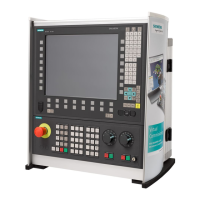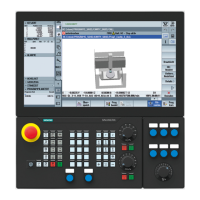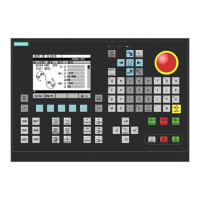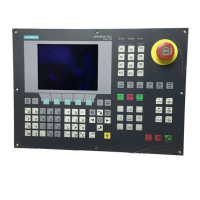Detailed Description
2.6 Interface structure
PLC Basic Program Solution Line (P3 sl)
2-32 Function Manual, 08/2005 Edition, 6FC5397-0BP10-0BA0
Interrupt messages are used to display error states on the machine, which will usually lead
to the machine being stopped. Where several errors occur in rapid succession, it is important
to be able to distinguish their order of occurrence for troubleshooting purposes. This is
indicated, on the one hand, by the order in which they are entered in the diagnostic buffer
and on the other, by the time stamp, which is assigned to every entry.
If the cause of the error disappears, the associated interrupt message is only deleted if the
user has acknowledged it (e.g. by pressing a key on the MCP). In response to this signal, the
"Message acquisition" FC examines which of the reported errors have disappeared and
enters these in the diagnostic buffer with the entry "Interrupt gone". This enables the HMI to
also maintain an up-to-date log of pending interrupt messages. The time of day indicating the
time at which the error occurred is maintained for messages, which are still pending (in
contrast to a received interrogation).
User program
The user PLC program merely needs to call the basic program block FC 10 with appropriate
parameter settings in the cyclic program section and set or reset the bit fields in DB2. All
further necessary measures are implemented by the basic program and HMI.
$/$50B6
$/$50B64
6)&
+0,23
3*
)HHGGLVDEOH
5HDGLQGLVDEOH
1&VWDUWGLVDEOH
&KDQQHO
&KDQQHOQ
$[LVVSLQGOH
$[LVVSLQGOHQ
)HHGUDWHVSLQG
OHGLVDEOH
0HVVDJH
DFTXLVLWLRQ
,QWHUUXSW
EXIIHU
0HVVDJHVHUYLFH
$FTXLVLWLRQ
RIJURXSVLJQDOV
IRUFKDQQHODQG
D[LV'%
*URXSVLJQDOV
GLVDEOHVLJQDOV
%LWILHOGV
&KDQJHVLJQDOV
8VHUDUHD
Fig. 2-9 Acquisition and signaling of PLC events
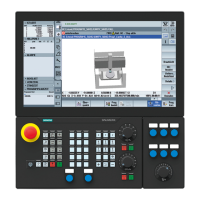
